Teaching artists, museum staff, and older adults discuss the ways that inclusive and culturally-responsive programs impact teaching, artmaking, and the museums in which they’re offered.
As Lifetime Arts co-founder/CEO Maura O’Malley write last year in Museum magazine, “For cultural organizations like museums, creative aging extends their reach; advances their educational, cultural, and social missions; builds new community partnerships, and creates new funding streams.”
Museums are critical programming sites in the creative aging field as they provide a foundation for artists and museum educators to offer high-quality arts education programs that foster inclusivity, diversity, self-expression, and community engagement among older adults through an enriching curriculum.
The following are examples of programs offered in museums across the U.S. — during and immediately prior to the pandemic — in which teaching artists centered their curriculum in Black cultures and history and/or taught media inspired by Black and Brown artists.
These programs are part of E.A. Michelson Philanthropy’s Seeding Vitality Arts in Museums Initiative. Lifetime Arts educated and coached teaching artists, museum educators, and staff in support of the planning and delivery of these programs.
Louisiana State Museum, Louisiana
Congo Square: Drumming for Life Workshop
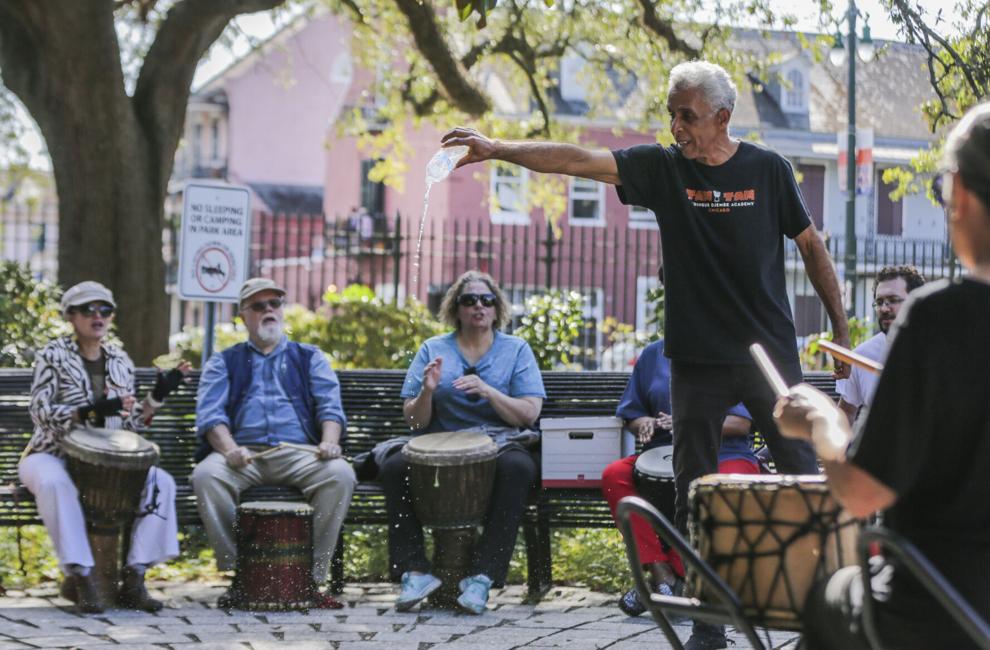
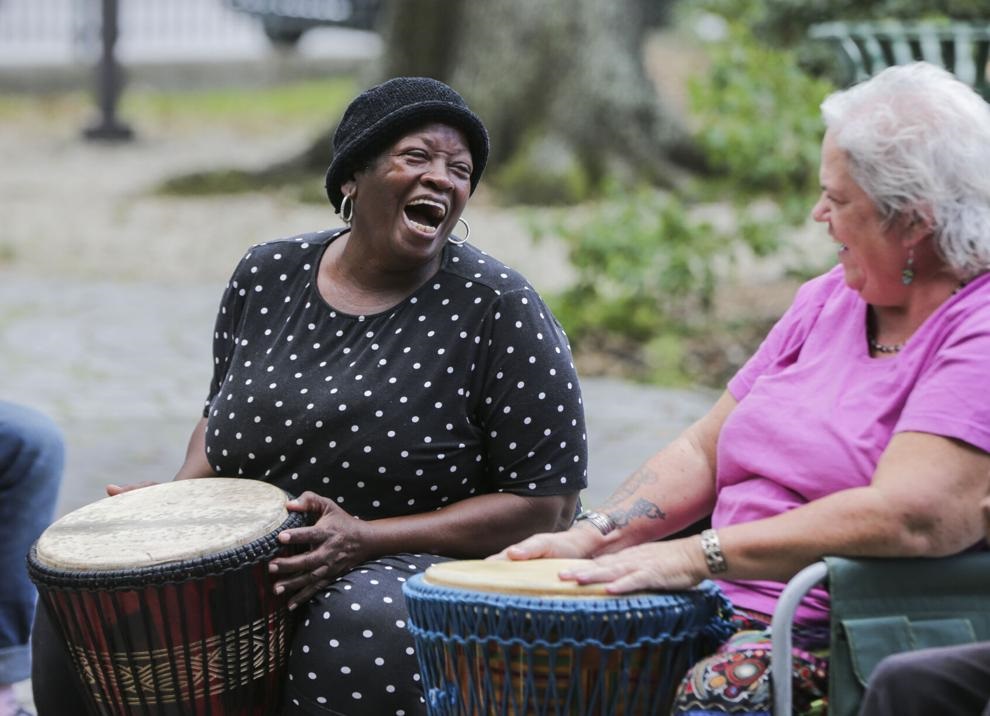
Teaching artist, Luther Gray (pictured standing in left photo), starts the class, “Congo Square: Drumming for Life Workshop,” by pouring libations for ancestors onto the cobblestones of Congo Square. Credit: Nola.com/Sophia Germer
In October 2021, the Louisiana State Museum offered the program, “Congo Square: Drumming for Life Workshop,” an interactive percussion experience using African, Latin, and New Orleans instruments. The program was taught by Luther Gray of Bamboula 2000, who introduced students to the class with a tour of the Drumsville Exhibit at the New Orleans Jazz Museum where they learned the roots and development of the New Orleans beat from Congo Square to 21st-century rhythms.
The program culminated in a performance in Congo Square, a historical area where enslaved peoples had been allowed to congregate for dancing and drumming to the rhythms of their African and Caribbean homelands. Students narrated and played 1st Nation People of New Orleans rhythms; African rhythms; rhythms with French, Spanish, and Caribbean influences; the roots of New Orleans rhythm known as the “second line” tradition; Black Masking Indian rhythms; and jazz. Luther was joined by teaching artist, Big Chief Darryl Montana of the Yellow Pocahontas Mardi Gras Indian Tribe and dance instructors, Kai Knight and Mama Jamilah.
“Students have come from a wide range of backgrounds, including lifelong New Orleanians and relative new comers, and formed meaningful, lasting community. Many students have bought their own drums since the conclusion of the classes, and joined the weekly drumming on Sundays at Congo Square, a historic tradition first started by Indigenous and enslaved people hundreds of years ago.”
Sara Lowenburg, Manager of Education, Louisiana State Museum
For more photos from the culminating event, please view this collection by photographer, Sophia Germer, at Nola.com.
Beading with the Big Chief
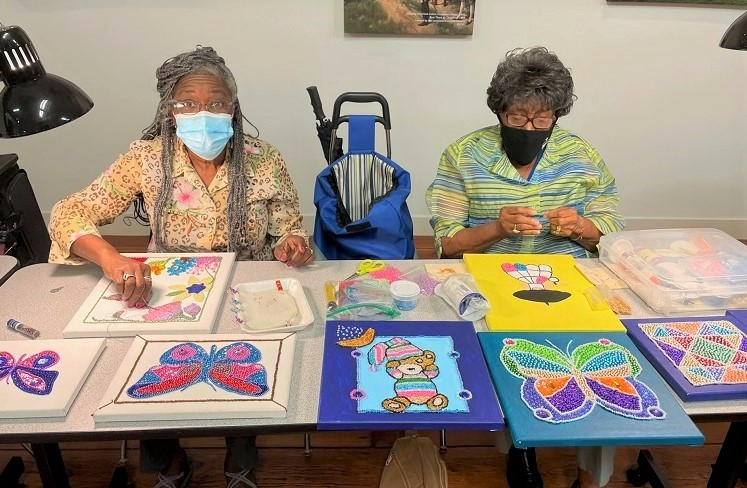
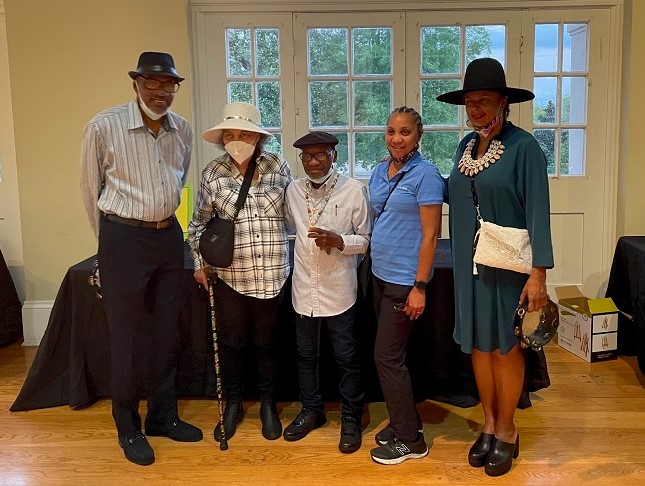
Participants (pictured left) work on their beading pieces during the workshop, “Beading with Big Chief”. Big Chief Darryl Montana (pictured at right, center) at the culminating event. Credit: Sara Lowenburg
In July 2021, teaching artist Big Chief Darryl Montana of the Yellow Pocahontas Mardi Gras Indian Tribe led a group of older adults through the eight-week workshop, “Beading with the Big Chief.” The class was designed to immerse participants in the culture and history of Mardi Gras Indian masking traditions and techniques. Through storytelling, video, visuals, and museum exploration (featuring the We Love You, New Orleans and Mystery in Motion: African American Masking and Spirituality in Mardi Gras exhibitions), students learned about the significance of the suits, the different roles of the members of the tribe and their responsibilities.
Chief Montana also taught students the technique behind the beading, including uptown 2-D style and downtown 3-D style, and the different parts of each suit. Chief Montana was joined by teaching artist, Dianne “Gumbo Marie” Honore’, who is Big Queen of the Yellow Pocahontas Black Masking Indians, and an experienced cultural educator at historic sites around Louisiana.
“Though the courses have varied in medium and format, each has been rooted in Louisiana history and culture, highlighted the work of local creators and culture bearers, and helped build community within the class and the city at large. Supporting the museum’s mission to preserve and interpret Louisiana history and culture, these courses have strengthened connections with local audiences, built diverse communities of older adults, and created new interpretations of Louisiana history and culture through students’ art.”
Sara Lowenburg, Manager of Education, Louisiana State Museum
For the 49th annual Mardi Gras Parade held on March 1, 2022 in New Orleans, Chief Montana invited Mr. Raymond Lewis, a 92-year-old participant, to mask with the tribe as Chief Counsel, a position of honor intended for an older tribesman with wisdom, courage, and lessons to teach. Chief Montana also invited students from the summer course to create and assemble Lewis’ suit for the ritual.
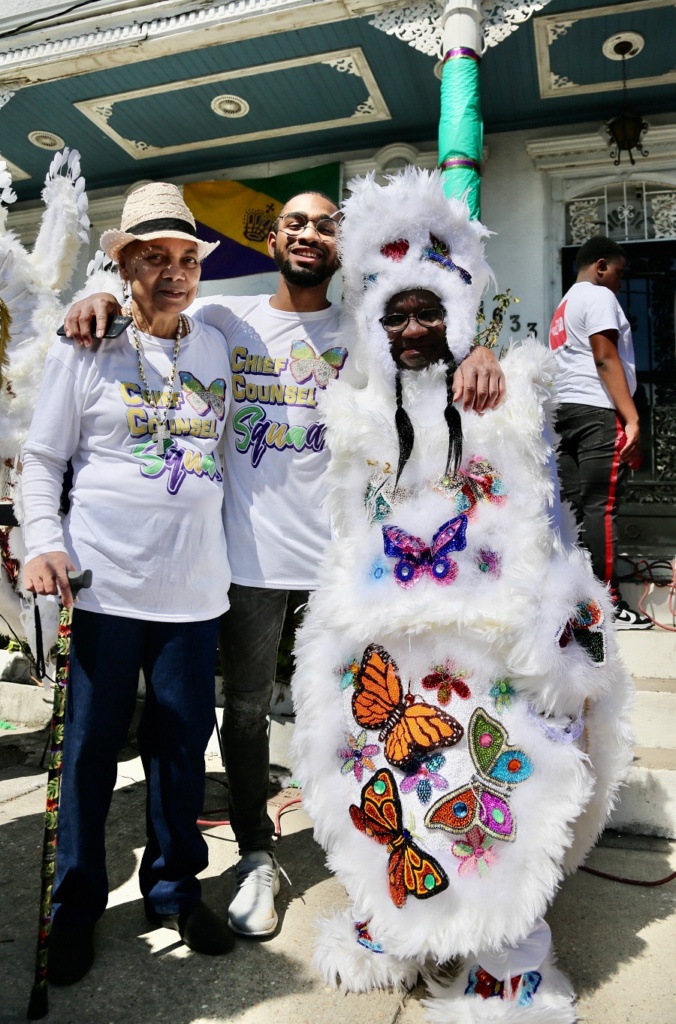
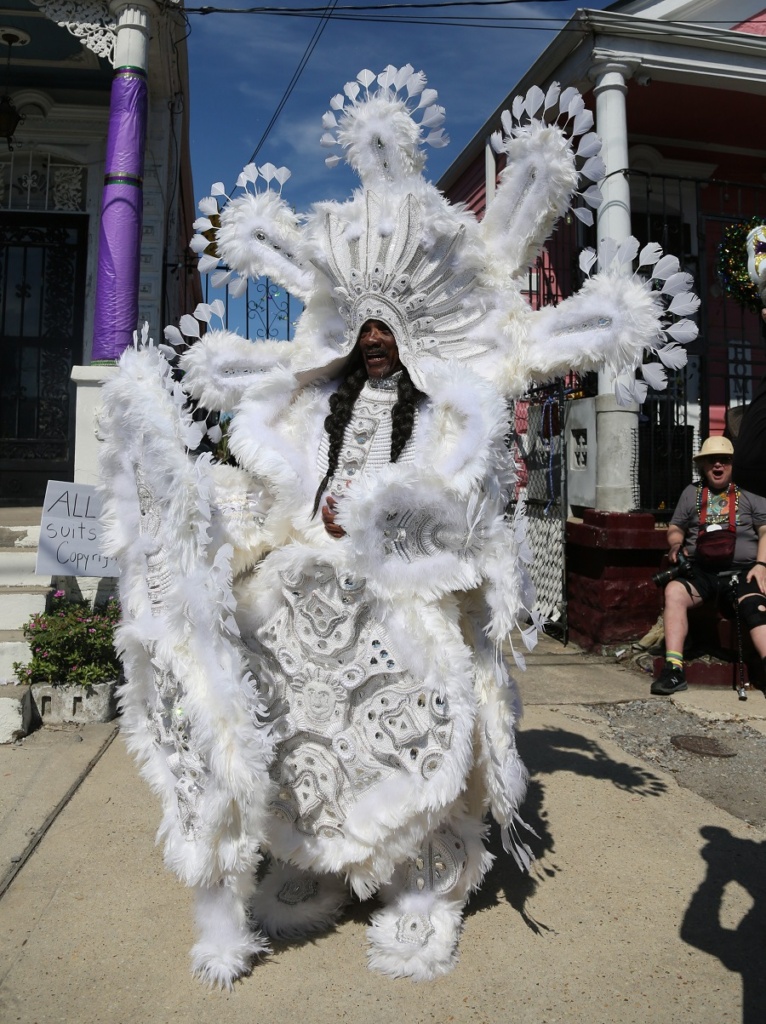
To learn more about the Black Masking Indian Tribe and Big Chief’s 49th Mardi Gras celebration, please watch the video below from Good Morning America.
For more information about this program, please view, “Behind the Scenes at the Cabildo with Big Chief Darryl Montana,” to see Chief Montana take viewers on a tour of the program’s exhibition of participant work and discuss Black Masking traditions.
Speed Art Museum, Kentucky
The following two workshops are part of Speed Art Museum‘s program, “Community Connections,” which aims to amplify marginalized voices through artmaking. Now in its fifth year, the program brings contemporary art from diverse experiences into the museum through community collaborations.
Collage Techniques in Stylized Self-Portraits

In July 2021, teaching artist JaBani Bennett taught the visual arts program, “Collage Techniques in Stylized Self-Portraits.” Over the course of eight sessions, participants explored collage techniques centered in photography as a method to assemble different materials to create a stylized self-portrait. JaBani introduced students to the work of Janine Antoni and Lorna Simpson as inspiration for their final pieces. The resulting self-portraits represented participants’ hopes and aspirations for 2022. The program emphasized approaches that encouraged community building through social-emotional wellness and increased self-awareness about how social identities shape their lives.
“In my teaching experience, I can present an array of new (and less visible) artists and creative approaches across diverse cultures to older adults. Through exposure, older artist participants can be courageous in their own experimentation to tell their authentic stories.”
JaBani Bennett, Teaching Artist
Monotype Printmaking
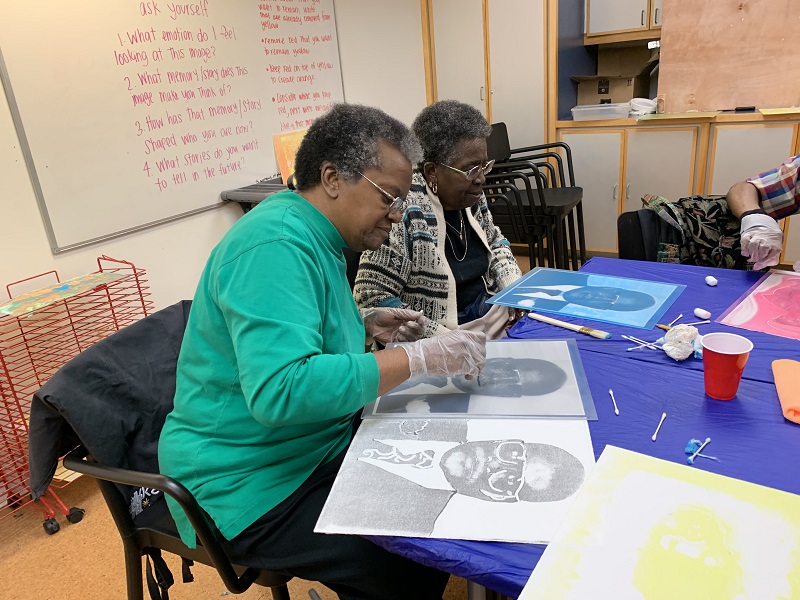
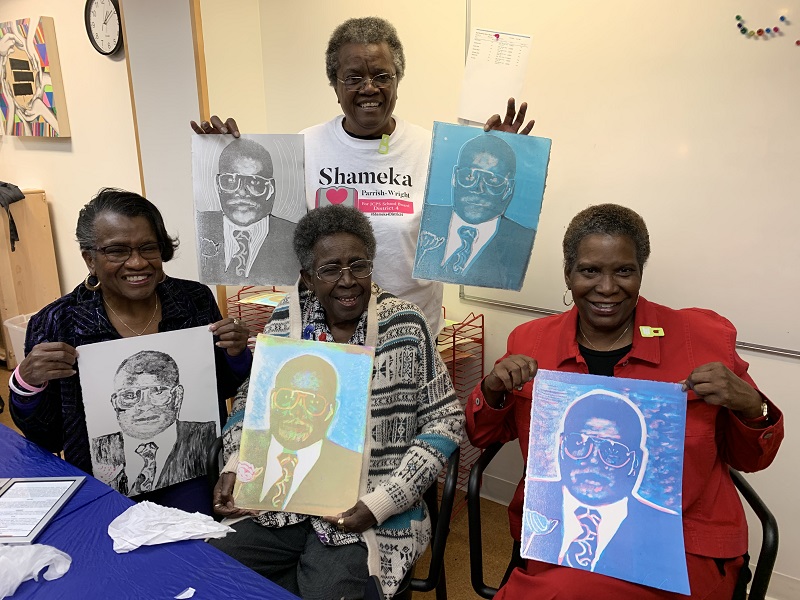
Participants work on their prints during the program, “Monotype Printmaking,” taught by Rodolfo Salgado Jr. Credit: Toya Northington
In 2019, teaching artist Rodolfo Salgado Jr. taught “Monotype Printmaking,” at the Speed. This eight-week program taught participants how prints are made using various techniques and skills to create elaborate CMYK posters. The resulting posters, created in the style of brotherhood and propaganda posters typical of the West End, were inspired by Kentucky-born African American artist, Bert Hurley, and his work, “Loose Nuts: A Rapsody in Brown,” a 125-page novella exhibited at the Speed.
“When people of color or older people can see others like them making work, they can build community around making art, have conversations they wouldn’t have before, and feel that the collection and spaces of the museum are more available to them — especially when their work is exhibited at the very museum they made it in.”
Rodolfo Salgado Jr., Teaching Artist
“These types of programs are changing the landscape of museums. They are allowing diverse narratives and new artistic points of view to enter the space. We often think of self-expression as something that benefits diverse groups and it does when those programs are planned with cultural humility and intentionality, but really it enhances the institutions because they are exposed to new ideas and perspectives. People outside the art world see art in fresh and new ways.”
Toya Northington, Interim Co-Director of Education, Community Engagement Strategist, Speed Art Museum
To learn more about this program and others that are part of the Community Connections program, please watch the video, “Our Life, Our Stories,” created by the Speed Art Museum.
Ohio History Connection, Ohio
Introduction to African-Inspired Handmade Beads and Jewelry
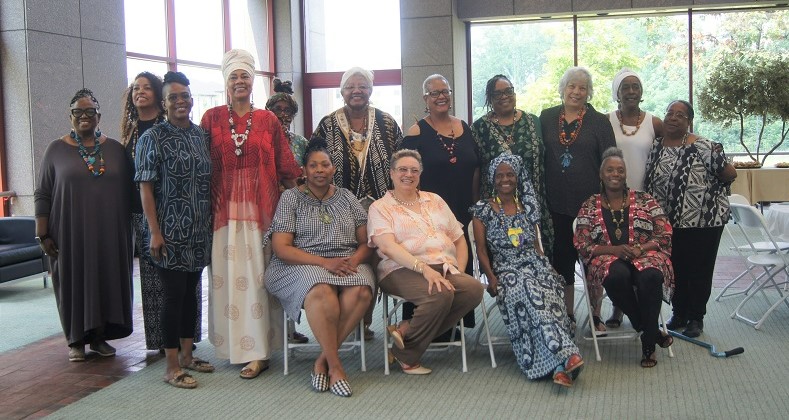
In June 2021, the Ohio History Connection offered the eight-week program, “Introduction to African-Inspired Handmade Beads and Jewelry,” taught by Rosa Rojas. Rosa introduced students to the various ways body adornments are used in Africa and how producing them “in community” unifies the members. In addition to using readily available bead-making supplies, students incorporated found objects, upcycled materials, and personal treasures to create their final pieces.
“The African inspired jewelry class awakened my appreciation for the jewelry designs and styles from different African countries and sparked a desire for me to research and learn more. In addition, it gave me the opportunity to create jewelry using African beads and polymer clay (a medium that was new to me).”
Karen Saunders, Participant
“As I reflect on my experience in the Afro-American jewelry class, I cannot help but be filled with hope for tomorrow. The class awakened a sense of inspiration and hope that I had needed for so long after being disabled with seizures. The ability to concentrate and create with my hands was a miracle to me.”
Aldelphia Faye Saunders, Participant
The success of these programs and several others part of this initiative continue to increase engagement, trust, belonging, and endless learning opportunities for older adults across the country. With the support of local artists and partners, museum educators and staff are creating supportive and sustainable programming that encourages every older adult to unleash their inner artist and elevate their voices and stories together through art.

